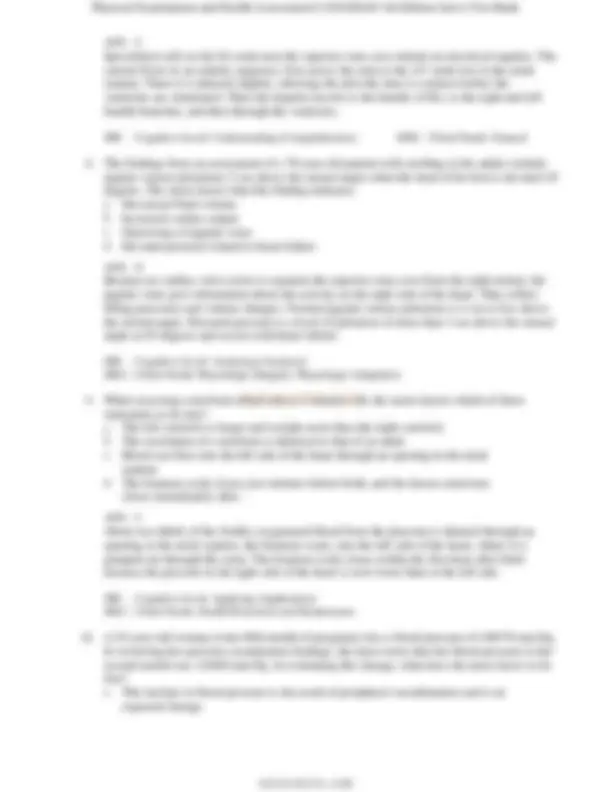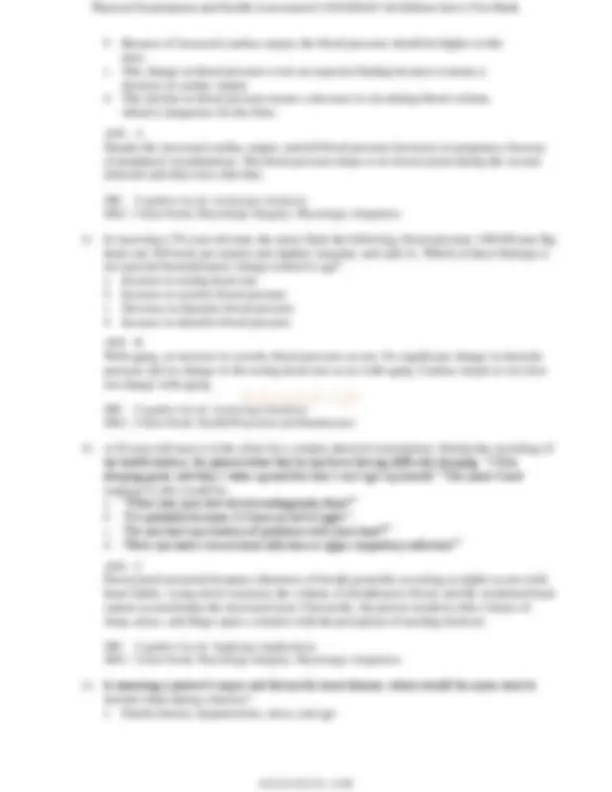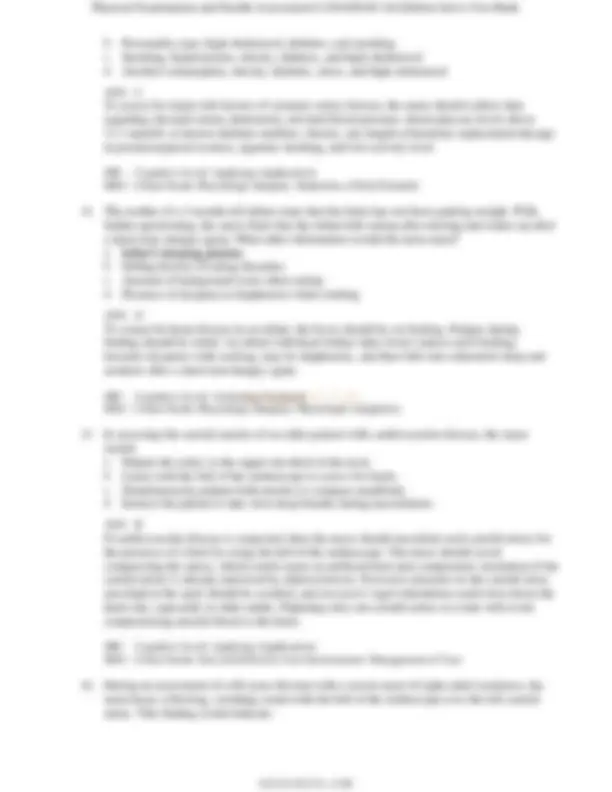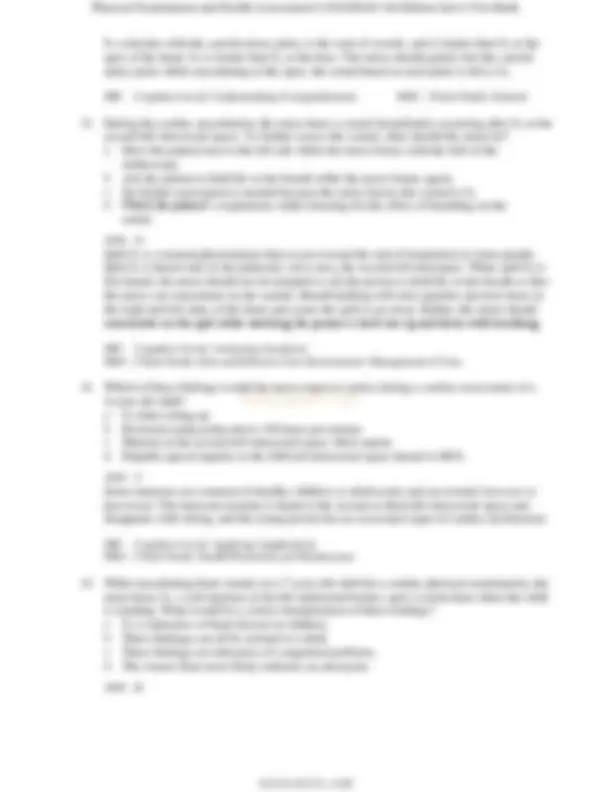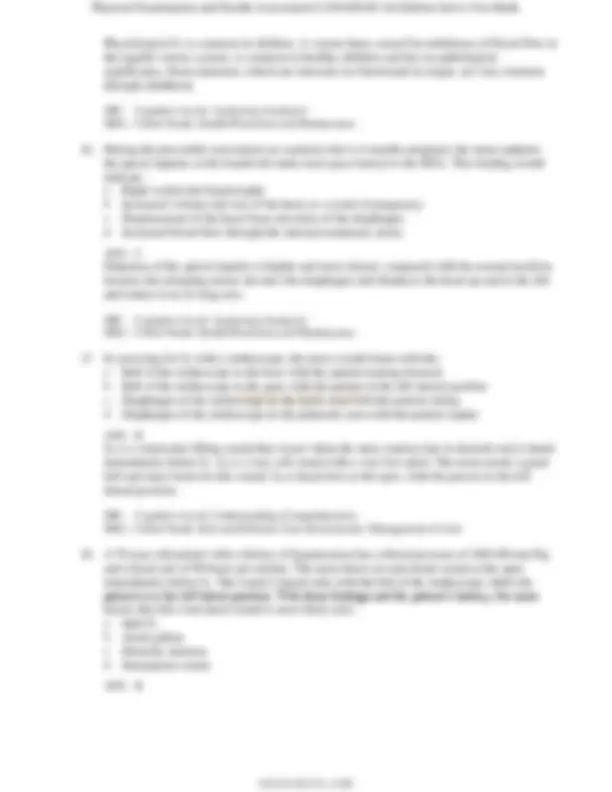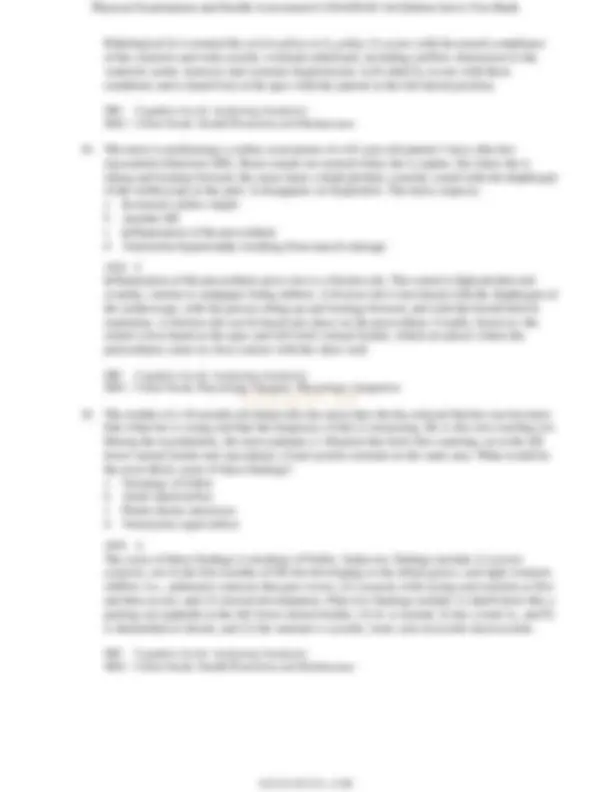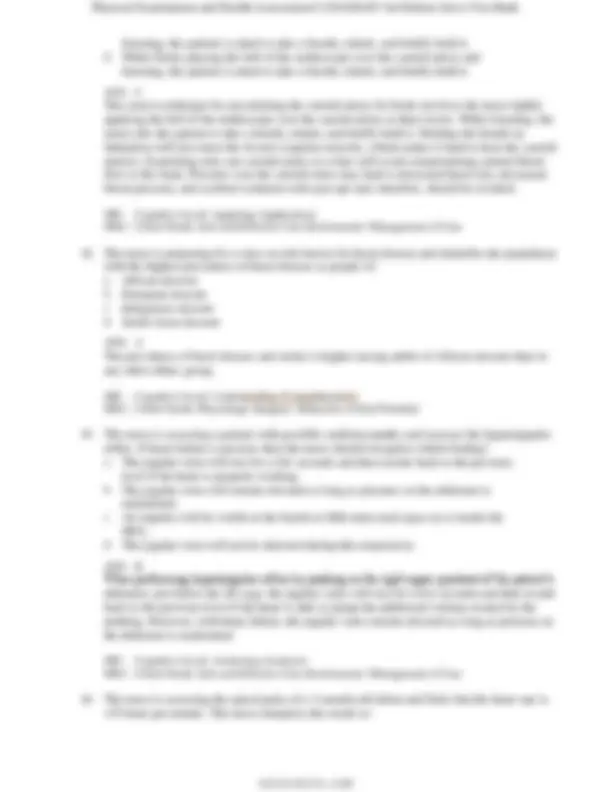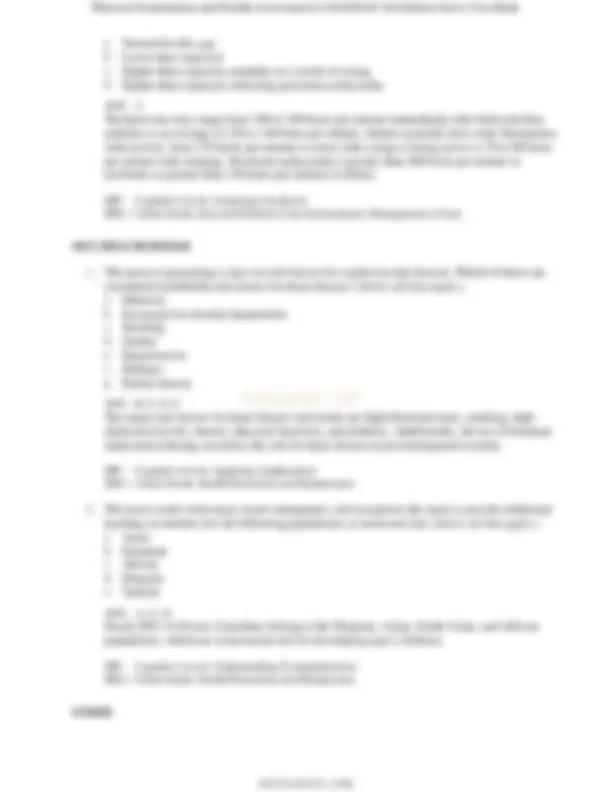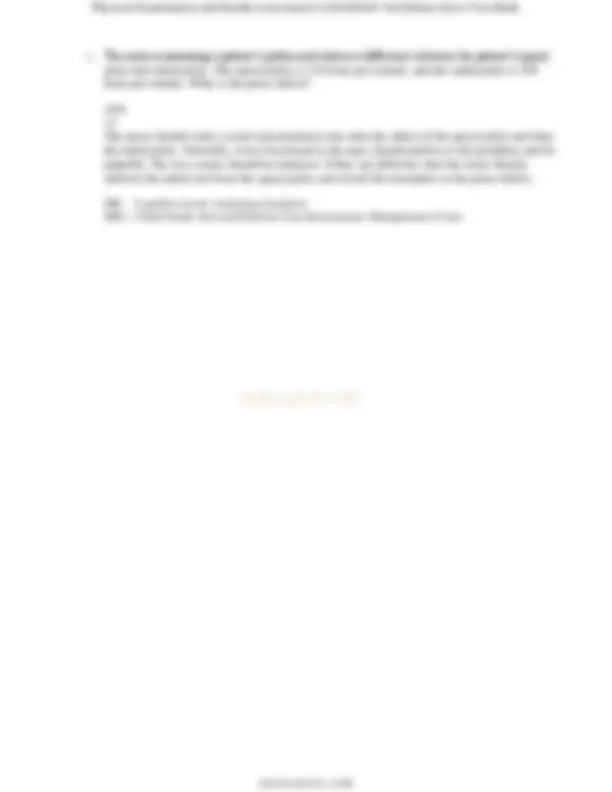Download Test Bank - Physical Examination & Health Assessment, Heart and Neck Vessels. (2023-2024) and more Exams Nursing in PDF only on Docsity!
NURSINGTB.COM
Chapter 20: Heart and Neck Vessels
Jarvis: Physical Examination & Health Assessment, 3rd Canadian edition
MULTIPLE CHOICE
- When assessing a patient’s cardiovascular system, the nurse notes a high pitched scratchy sound at the apex of the heart. The nurse recognizes this as rubbing between the two walls of the sac surrounding and protecting the heart, called the: a. (^) Pericardium b. (^) Myocardium c. (^) Endocardium d. (^) Pleural space ANS: A The pericardium is a tough, fibrous, double-walled sac that surrounds and protects the heart. It has two layers that contain a few millilitres of serous pericardial fluid. Inflammation of the precordium gives rise to a friction rub. The sound is high pitched and scratchy, like sandpaper being rubbed. DIF: Cognitive Level: Understanding (Comprehension) MSC: Client Needs: General
- The direction of blood flow through the heart is best described by which of these? a. (^) Vena cava right atrium right ventricle lungs pulmonary artery left atrium left ventricle b. (^) Right atrium right ventricle pulmonary artery lungs pulmonary vein left atrium left ventricle c. (^) Aorta right atrium right ventricle lungs pulmonary vein left atrium left ventricle vena cava d. (^) Right atrium right ventricle pulmonary vein lungs pulmonary artery left atrium left ventricle ANS: B Returning blood from the body empties into the right atrium, flows into the right ventricle, and then goes to the lungs through the pulmonary artery. The lungs oxygenate blood, and it is then returned to the left atrium through the pulmonary vein. Blood goes from there to the left ventricle and then to the aorta and out to other areas of the body. DIF: Cognitive Level: Remembering (Knowledge) MSC: Client Needs: General
- The nurse is reviewing the anatomy and physiological functioning of the heart. Which statement best describes what is meant by atrial kick? a. (^) The atria contract during systole and attempt to push against closed valves. b. (^) Contraction of the atria at the beginning of diastole can be felt as a palpitation. c. (^) Atrial kick is the pressure exerted against the atria as the ventricles contract during systole. d. (^) The atria contract toward the end of diastole and push the remaining blood into the ventricles. ANS: D
NURSINGTB.COM
Toward the end of diastole, the atria contract and push the last amount of blood (approximately 25% of stroke volume) into the ventricles. This active filling phase is called presystole , or atrial systole, or sometimes the atrial kick. DIF: Cognitive Level: Remembering (Knowledge) MSC: Client Needs: General
- When listening to heart sounds, the nurse knows the valve closures that can be heard best at the base of the heart are: a. (^) Mitral and tricuspid b. (^) Tricuspid and aortic c. (^) Aortic and pulmonic d. (^) Mitral and pulmonic ANS: C The second heart sound (S 2 ) occurs with the closure of the semilunar (aortic and pulmonic) valves and signals the end of systole. Although it is heard over all the precordium, the S 2 is loudest at the base of the heart. DIF: Cognitive Level: Understanding (Comprehension) MSC: Client Needs: General
- Which of these statements describes the closure of the valves in a normal cardiac cycle? a. (^) The aortic valve closes slightly before the tricuspid valve. b. (^) The pulmonic valve closes slightly before the aortic valve. c. (^) The tricuspid valve closes slightly later than the mitral valve. d. (^) Both the tricuspid and pulmonic valves close at the same time. ANS: C Events occur just slightly later in the right side of the heart because of the route of myocardial depolarization. As a result, two distinct components to each of the heart sounds exist, and sometimes they can be heard separately. In the first heart sound, the mitral component (M1) closes just before the tricuspid component (T1). DIF: Cognitive Level: Understanding (Comprehension) MSC: Client Needs: General
- The component of the conduction system referred to as the pacemaker of the heart is the: a. (^) Atrioventricular (AV) node b. (^) Sinoatrial (SA) node c. (^) Bundle of His d. (^) Bundle branches ANS: B Specialized cells in the SA node near the superior vena cava initiate an electrical impulse. Because the SA node has an intrinsic rhythm, it is called the pacemaker of the heart. DIF: Cognitive Level: Remembering (Knowledge) MSC: Client Needs: General
- The electrical stimulus of the cardiac cycle follows which sequence? a. (^) AV node SA node bundle of His b. (^) Bundle of His AV node SA node c. (^) SA node AV node bundle of His bundle branches d. (^) AV node SA node bundle of His bundle branches
NURSINGTB.COM
b. (^) Because of increased cardiac output, the blood pressure should be higher at this time. c. (^) This change in blood pressure is not an expected finding because it means a decrease in cardiac output. d. (^) This decline in blood pressure means a decrease in circulating blood volume, which is dangerous for the fetus. ANS: A Despite the increased cardiac output, arterial blood pressure decreases in pregnancy because of peripheral vasodilatation. The blood pressure drops to its lowest point during the second trimester and then rises after that. DIF: Cognitive Level: Analyzing (Analysis) MSC: Client Needs: Physiologic Integrity: Physiologic Adaptation
- In assessing a 70-year-old man, the nurse finds the following: blood pressure 140/100 mm Hg; heart rate 104 beats per minute and slightly irregular; and split S 2. Which of these findings is an expected hemodynamic change related to age? a. (^) Increase in resting heart rate b. (^) Increase in systolic blood pressure c. (^) Decrease in diastolic blood pressure d. (^) Increase in diastolic blood pressure ANS: B With aging, an increase in systolic blood pressure occurs. No significant change in diastolic pressure and no change in the resting heart rate occur with aging. Cardiac output at rest does not change with aging. DIF: Cognitive Level: Analyzing (Analysis) MSC: Client Needs: Health Promotion and Maintenance
- A 45-year-old man is in the clinic for a routine physical examination. During the recording of his health history, the patient states that he has been having difficulty sleeping. “I’ll be sleeping great, and then I wake up and feel like I can’t get my breath.” The nurse’s best response to this would be: a. (^) “When was your last electrocardiography done?” b. (^) “It’s probably because it’s been so hot at night.” c. (^) “Do you have any history of problems with your heart?” d. (^) “Have you had a recent sinus infection or upper respiratory infection?” ANS: C Paroxysmal nocturnal dyspnea (shortness of breath generally occurring at night) occurs with heart failure. Lying down increases the volume of intrathoracic blood, and the weakened heart cannot accommodate the increased load. Classically, the person awakens after 2 hours of sleep, arises, and flings open a window with the perception of needing fresh air. DIF: Cognitive Level: Applying (Application) MSC: Client Needs: Physiologic Integrity: Physiologic Adaptation
- In assessing a patient’s major risk factors for heart disease, which would the nurse want to include when taking a history? a. (^) Family history, hypertension, stress, and age
NURSINGTB.COM
b. (^) Personality type, high cholesterol, diabetes, and smoking c. (^) Smoking, hypertension, obesity, diabetes, and high cholesterol d. (^) Alcohol consumption, obesity, diabetes, stress, and high cholesterol ANS: C To assess for major risk factors of coronary artery disease, the nurse should collect data regarding elevated serum cholesterol, elevated blood pressure, blood glucose levels above 11.1 mmol/L or known diabetes mellitus, obesity, any length of hormone replacement therapy in postmenopausal women, cigarette smoking, and low activity level. DIF: Cognitive Level: Applying (Application) MSC: Client Needs: Physiologic Integrity: Reduction of Risk Potential
- The mother of a 3-month-old infant states that her baby has not been gaining weight. With further questioning, the nurse finds that the infant falls asleep after nursing and wakes up after a short time, hungry again. What other information would the nurse need? a. (^) Infant’s sleeping position b. (^) Sibling history of eating disorders c. (^) Amount of background noise when eating d. (^) Presence of dyspnea or diaphoresis when sucking ANS: D To screen for heart disease in an infant, the focus should be on feeding. Fatigue during feeding should be noted. An infant with heart failure takes fewer ounces each feeding, becomes dyspneic with sucking, may be diaphoretic, and then falls into exhausted sleep and awakens after a short time hungry again. DIF: Cognitive Level: Analyzing (Analysis) MSC: Client Needs: Physiologic Integrity: Physiologic Adaptation
- In assessing the carotid arteries of an older patient with cardiovascular disease, the nurse would: a. (^) Palpate the artery in the upper one-third of the neck. b. (^) Listen with the bell of the stethoscope to assess for bruits. c. (^) Simultaneously palpate both arteries to compare amplitude. d. (^) Instruct the patient to take slow deep breaths during auscultation. ANS: B If cardiovascular disease is suspected, then the nurse should auscultate each carotid artery for the presence of a bruit by using the bell of the stethoscope. The nurse should avoid compressing the artery, which could create an artificial bruit and compromise circulation if the carotid artery is already narrowed by atherosclerosis. Excessive pressure on the carotid sinus area high in the neck should be avoided, and excessive vagal stimulation could slow down the heart rate, especially in older adults. Palpating only one carotid artery at a time will avoid compromising arterial blood to the brain. DIF: Cognitive Level: Applying (Application) MSC: Client Needs: Safe and Effective Care Environment: Management of Care
- During an assessment of a 68-year-old man with a recent onset of right-sided weakness, the nurse hears a blowing, swishing sound with the bell of the stethoscope over the left carotid artery. This finding would indicate:
NURSINGTB.COM
Numerous comparison studies have shown that the percussed cardiac border correlates only moderately with the true cardiac border. Percussion is of limited usefulness in the female breast tissue, in a person who is obese, or in a person with a muscular chest wall. Chest radiography and echocardiography are significantly more accurate in detecting heart enlargement. DIF: Cognitive Level: Understanding (Comprehension) MSC: Client Needs: Safe and Effective Care Environment: Management of Care
- The nurse is preparing to auscultate for heart sounds. Which technique is correct? a. (^) Listening to the sounds at the aortic, tricuspid, pulmonic, and mitral areas b. (^) Listening by inching the stethoscope in a rough “Z” pattern, from the base of the heart across and down, then over to the apex c. (^) Listening to the sounds only at the site where the apical pulse is felt to be the strongest d. (^) Listening for all possible sounds at a time at each specified area ANS: B Auscultation of breath sounds should not be limited to only four locations. Sounds produced by the valves may be heard all over the precordium. The stethoscope should be inched in a rough “Z” pattern from the base of the heart, across and down, and then over to the apex; or, starting at the apex, it should be slowly worked up (see Figure 20-20). Listening selectively to one sound at a time is best. DIF: Cognitive Level: Understanding (Comprehension) MSC: Client Needs: Safe and Effective Care Environment: Management of Care
- While counting the apical pulse on a 16-year-old patient, the nurse notices an irregular rhythm. His rate speeds up on inspiration and slows on expiration. What would be the nurse’s response? a. (^) Talk with the patient about his intake of caffeine. b. (^) Perform ECG after the examination. c. (^) No further response is needed because sinus arrhythmia can occur normally. d. (^) Refer the patient to a cardiologist for further testing. ANS: C The rhythm should be regular, although sinus arrhythmia occurs normally in young adults and children. With sinus arrhythmia, the rhythm varies with the person’s breathing, increasing at the peak of inspiration and slowing with expiration. DIF: Cognitive Level: Analyzing (Analysis) MSC: Client Needs: Health Promotion and Maintenance
- When listening to heart sounds, the nurse knows that S 1 : a. (^) Is louder than S 2 at the base of the heart. b. (^) Indicates the beginning of diastole. c. (^) Coincides with the carotid artery pulse. d. Is caused by the closure of the semilunar valves. ANS: C
NURSINGTB.COM
S 1 coincides with the carotid artery pulse, is the start of systole, and is louder than S 2 at the apex of the heart; S 2 is louder than S 1 at the base. The nurse should gently feel the carotid artery pulse while auscultating at the apex; the sound heard as each pulse is felt is S 1. DIF: Cognitive Level: Understanding (Comprehension) MSC: Client Needs: General
- During the cardiac auscultation, the nurse hears a sound immediately occurring after S 2 at the second left intercostal space. To further assess this sound, what should the nurse do? a. (^) Have the patient turn to the left side while the nurse listens with the bell of the stethoscope. b. (^) Ask the patient to hold his or her breath while the nurse listens again. c. (^) No further assessment is needed because the nurse knows this sound is S 3. d. (^) Watch the patient’s respirations while listening for the effect of breathing on the sound. ANS: D Split S 2 is a normal phenomenon that occurs toward the end of inspiration in some people. Split S 2 is heard only in the pulmonic valve area, the second left interspace. When split S 2 is first heard, the nurse should not be tempted to ask the person to hold his or her breath so that the nurse can concentrate on the sounds. Breath holding will only equalize ejection times in the right and left sides of the heart and cause the split to go away. Rather, the nurse should concentrate on the split while watching the person’s chest rise up and down with breathing. DIF: Cognitive Level: Analyzing (Analysis) MSC: Client Needs: Safe and Effective Care Environment: Management of Care
- Which of these findings would the nurse expect to notice during a cardiac assessment of a 4 - year-old child? a. (^) S 3 when sitting up b. (^) Persistent tachycardia above 150 beats per minute c. (^) Murmur at the second left intercostal space when supine d. (^) Palpable apical impulse in the fifth left intercostal space lateral to MCL ANS: C Some murmurs are common in healthy children or adolescents and are termed innocent or functional. The innocent murmur is heard at the second or third left intercostal space and disappears with sitting, and the young person has no associated signs of cardiac dysfunction. DIF: Cognitive Level: Applying (Application) MSC: Client Needs: Health Promotion and Maintenance
- While auscultating heart sounds on a 7-year-old child for a routine physical examination, the nurse hears S 3 , a soft murmur at the left midsternal border, and a venous hum when the child is standing. What would be a correct interpretation of these findings? a. (^) S 3 is indicative of heart disease in children. b. (^) These findings can all be normal in a child. c. (^) These findings are indicative of congenital problems. d. (^) The venous hum most likely indicates an aneurysm. ANS: B
NURSINGTB.COM
Pathological S 4 is termed the atrial gallop or S 4 gallop. It occurs with decreased compliance of the ventricle and with systolic overload (afterload), including outflow obstruction to the ventricle (aortic stenosis) and systemic hypertension. Left-sided S 4 occurs with these conditions and is heard best at the apex with the patient in the left lateral position. DIF: Cognitive Level: Analyzing (Analysis) MSC: Client Needs: Health Promotion and Maintenance
- The nurse is performing a cardiac assessment of a 65-year-old patient 3 days after her myocardial infarction (MI). Heart sounds are normal when she is supine, but when she is sitting and leaning forward, the nurse hears a high-pitched, scratchy sound with the diaphragm of the stethoscope at the apex. It disappears on inspiration. The nurse suspects: a. (^) Increased cardiac output b. (^) Another MI c. (^) Inflammation of the precordium d. (^) Ventricular hypertrophy resulting from muscle damage ANS: C Inflammation of the precordium gives rise to a friction rub. The sound is high pitched and scratchy, similar to sandpaper being rubbed. A friction rub is best heard with the diaphragm of the stethoscope, with the person sitting up and leaning forward, and with the breath held in expiration. A friction rub can be heard any place on the precordium. Usually, however, the sound is best heard at the apex and left lower sternal border, which are places where the pericardium comes in close contact with the chest wall. DIF: Cognitive Level: Analyzing (Analysis) MSC: Client Needs: Physiologic Integrity: Physiologic Adaptation
- The mother of a 10-month-old infant tells the nurse that she has noticed that her son becomes blue when he is crying and that the frequency of this is increasing. He is also not crawling yet. During the examination, the nurse palpates a vibration that feels like a purring cat at the left lower sternal border and auscultates a loud systolic murmur in the same area. What would be the most likely cause of these findings? a. (^) Tetralogy of Fallot b. Atrial septal defect c. (^) Patent ductus arteriosus d. (^) Ventricular septal defect ANS: A The cause of these findings is tetralogy of Fallot. Subjective findings include (1) severe cyanosis, not in the first months of life but developing as the infant grows, and right ventricle outflow (i.e., pulmonic) stenosis that gets worse; (2) cyanosis with crying and exertion at first and then at rest; and (3) slowed development. Objective findings include (1) thrill (feels like a purring cat) palpable at the left lower sternal border; (2) S 1 is normal, S 2 has a loud A 2 , and P 2 is diminished or absent; and (3) the murmur is systolic, loud, and crescendo–decrescendo. DIF: Cognitive Level: Analyzing (Analysis) MSC: Client Needs: Health Promotion and Maintenance
NURSINGTB.COM
- A 30-year-old woman with a history of mitral valve problems states that she has been “very tired.” She has started waking up at night and feels like her “heart is pounding.” During the assessment, the nurse palpates a thrill and forceful pushing of the ventricle at the fifth left intercostal space MCL. In the same area, the nurse also auscultates a blowing, swishing sound right after S 1. These findings would be most consistent with: a. (^) Heart failure b. (^) Aortic stenosis c. (^) Pulmonary edema d. (^) Mitral regurgitation ANS: D These findings are consistent with mitral regurgitation. Subjective findings include fatigue, palpitation, and orthopnea, and objective findings are (1) a thrill in systole at the apex; (2) a lift (heave or forceful pushing of the ventricle) at the apex; (3) the apical impulse displaced down and to the left; (4) S 1 is diminished, S 2 is accentuated, and S 3 at the apex is often present; and (5) a pansystolic murmur that is often loud, blowing, best heard at the apex, and radiating well to the left axilla. DIF: Cognitive Level: Analyzing (Analysis) MSC: Client Needs: Physiologic Integrity: Physiologic Adaptation
- During a cardiac assessment of a 38-year-old patient in the hospital for “chest pain,” the nurse finds the following: jugular vein pulsations 4 cm above the sternal angle when the patient is elevated at 45 degrees, blood pressure 98/60 mm Hg, heart rate 130 beats per minute, ankle edema, difficulty breathing when supine, and S 3 on auscultation. Which of these conditions best explains the cause of these findings? a. (^) Fluid overload b. (^) Atrial septal defect c. (^) MI d. (^) Heart failure ANS: D Heart failure causes decreased cardiac output when the heart fails as a pump and the circulation becomes backed up and congested. Signs and symptoms include dyspnea, orthopnea, paroxysmal nocturnal dyspnea, decreased blood pressure, dependent and pitting edema, anxiety, confusion, jugular vein distention, and fatigue. S 3 is associated with heart failure and is always abnormal after 35 years of age. S 3 may be the earliest sign of heart failure. DIF: Cognitive Level: Analyzing (Analysis) MSC: Client Needs: Physiologic Integrity: Physiologic Adaptation
- The nurse knows that normal splitting of S 2 is associated with: a. (^) Expiration b. (^) Inspiration c. (^) Exercise state d. (^) Low resting heart rate ANS: B Normal or physiological splitting of S 2 is associated with inspiration because of the increased blood return to the right side of the heart, delaying closure of the pulmonic valve.
NURSINGTB.COM
listening, the patient is asked to take a breath, exhale, and briefly hold it. d. (^) While firmly placing the bell of the stethoscope over the carotid artery and listening, the patient is asked to take a breath, exhale, and briefly hold it. ANS: C The correct technique for auscultating the carotid artery for bruits involves the nurse lightly applying the bell of the stethoscope over the carotid artery at three levels. While listening, the nurse asks the patient to take a breath, exhale, and briefly hold it. Holding the breath on inhalation will also tense the levator scapulae muscles, which makes it hard to hear the carotid arteries. Examining only one carotid artery at a time will avoid compromising arterial blood flow to the brain. Pressure over the carotid sinus may lead to decreased heart rate, decreased blood pressure, and cerebral ischemia with syncope and, therefore, should be avoided. DIF: Cognitive Level: Applying (Application) MSC: Client Needs: Safe and Effective Care Environment: Management of Care
- The nurse is preparing for a class on risk factors for heart disease and identifies the population with the highest prevalence of heart disease as people of: a. (^) African descent b. (^) European descent c. (^) Indigenous descent d. (^) South Asian descent ANS: A The prevalence of heart disease and stroke is higher among adults of African descent than in any other ethnic group. DIF: Cognitive Level: Understanding (Comprehension) MSC: Client Needs: Physiologic Integrity: Reduction of Risk Potential
- The nurse is assessing a patient with possible cardiomyopathy and assesses the hepatojugular reflux. If heart failure is present, then the nurse should recognize which finding? a. (^) The jugular veins will rise for a few seconds and then recede back to the previous level if the heart is properly working. b. (^) The jugular veins will remain elevated as long as pressure on the abdomen is maintained. c. (^) An impulse will be visible at the fourth or fifth intercostal space at or inside the MCL. d. (^) The jugular veins will not be detected during this manoeuvre. ANS: B When performing hepatojugular reflux by pushing on the right upper quadrant of the patient’s abdomen, just below the rib cage, the jugular veins will rise for a few seconds and then recede back to the previous level if the heart is able to pump the additional volume created by the pushing. However, with heart failure, the jugular veins remain elevated as long as pressure on the abdomen is maintained. DIF: Cognitive Level: Analyzing (Analysis) MSC: Client Needs: Safe and Effective Care Environment: Management of Care
- The nurse is assessing the apical pulse of a 3-month-old infant and finds that the heart rate is 135 beats per minute. The nurse interprets this result as:
NURSINGTB.COM
a. (^) Normal for this age b. (^) Lower than expected c. (^) Higher than expected, probably as a result of crying d. (^) Higher than expected, reflecting persistent tachycardia ANS: A The heart rate may range from 100 to 180 beats per minute immediately after birth and then stabilize to an average of 120 to 140 beats per minute. Infants normally have wide fluctuations with activity, from 170 beats per minute or more with crying or being active to 70 to 90 beats per minute with sleeping. Persistent tachycardia is greater than 200 beats per minute in newborns or greater than 150 beats per minute in infants. DIF: Cognitive Level: Analyzing (Analysis) MSC: Client Needs: Safe and Effective Care Environment: Management of Care MULTIPLE RESPONSE
- The nurse is presenting a class on risk factors for cardiovascular disease. Which of these are considered modifiable risk factors for heart disease? ( Select all that apply .) a. (^) Ethnicity b. (^) Increased low-density lipoproteins c. (^) Smoking d. (^) Gender e. (^) Hypertension f. (^) Diabetes g. (^) Family history ANS: B, C, E, F The major risk factors for heart disease and stroke are high blood pressure, smoking, high cholesterol levels, obesity, physical inactivity, and diabetes. Additionally, the use of hormone replacement therapy increases the risk for heart disease in postmenopausal women. DIF: Cognitive Level: Applying (Application) MSC: Client Needs: Health Promotion and Maintenance
- The nurse works with many recent immigrants, and recognizes the need to provide additional teaching on diabetes for the following populations at increased risk: ( Select all that apply. ) a. (^) Asian b. (^) European c. (^) African d. (^) Hispanic e. (^) Turkish ANS: A, C, D Nearly 80% of all new Canadians belong to the Hispanic, Asian, South Asian, and African populations, which are at increased risk for developing type 2 diabetes. DIF: Cognitive Level: Understanding (Comprehension) MSC: Client Needs: Health Promotion and Maintenance OTHER

